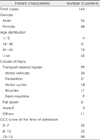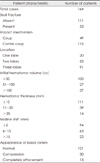Abstract
Objective
The purpose of this study was to analyze risk factors related to prognosis in patients treated for isolated traumatic acute subdural hematoma (ASDH).
Methods
A retrospective study of 164 blunt head trauma patients with isolated ASDH who were admitted to our hospital between January 2002 and December 2009 were reviewed. Information regarding age, sex, trauma mechanism, Glasgow Coma Scale (GCS) score, symptoms, brain computed tomography (CT) findings, hospital course and 6-months outcome were collected and analyzed.
Results
The overall mortality was 19.6% (32/164). A lower GCS score at the time of admission, the presence of brain herniation were identified as independent risk factors, while no independent association was observed between mortality and hematoma volume, thickness, midline shift and obliteration of patency of the basal cisterns, although these variables were correlated with mortality in univariate analyses.
Figures and Tables
TABLE 3
Results of univariate analyses relating the clinical variables to the outcome in patients for isolated traumatic acute subdural hematoma

TABLE 4
Results of univariate analyses relating the CT findings to the outcome in patients for isolated traumatic acute subdural hematoma

References
1. Bullock MR, Chesnut R, Ghajar J, Gordon D, Hartl R, Newell DW, et al. Surgical management of acute subdural hematomas. Neurosurgery. 2006; 58:S16–S24. discussion Si-Siv.

2. Croce MA, Dent DL, Menke PG, Robertson JT, Hinson MS, Young BH, et al. Acute subdural hematoma: nonsurgical management of selected patients. J Trauma. 1994; 36:820–826. discussion 826-827.
3. D'Amato L, Piazza O, Alliata L, Sabia G, Zito G, Frassanito L, et al. Prognosis of isolated acute post-traumatic subdural haematoma. J Neurosurg Sci. 2007; 51:107–111.
4. Gutman MB, Moulton RJ, Sullivan I, Hotz G, Tucker WS, Muller PJ. Risk factors predicting operable intracranial hematomas in head injury. J Neurosurg. 1992; 77:9–14.

5. Hatashita S, Koga N, Hosaka Y, Takagi S. Acute subdural hematoma: severity of injury, surgical intervention, and mortality. Neurol Med Chir (Tokyo). 1993; 33:13–18.

6. Jamieson KG, Yelland JDN. Surgically treated traumatic subdural haematoma: Review of 144 cases. J Neurosurg. 1972; 37:137–149.
7. Jiang J, Zhu C. Experimental and clinical studies of traumatic brain injury in China. Chin Med J (Engl). 1998; 111:180–182.
8. Miller SD, Statham PF. Surgical management of traumatic intracranial haematomas. In : Schmidek HH, Sweet WH, editors. Operative Neurosurgical Techniques. Philadelphia: W.B. Saunders Company;1995. p. 73–80.
9. Mosenthal AC, Lavery RF, Addis M, Kaul S, Ross S, Marburger R, et al. Isolated traumatic brain injury: age is an independent predictor of mortality and early outcome. J Trauma. 2002; 52:907–911.

10. Munro PT, Smith RD, Parke TR. Effect of patients' age on management of acute intracranial haematoma: prospective national study. BMJ. 2002; 325:1001.

11. Ono J, Yamaura A, Kubota M, Okimura Y, Isobe K. Outcome prediction in severe head injury: analyses of clinical prognostic factors. J Clin Neurosci. 2001; 8:120–123.

12. Phuenpathom N, Choomuang M, Ratanalert S. Outcome and outcome prediction in acute subdural hematoma. Surg Neurol. 1993; 40:22–25.

13. Sakas DE, Bullock MR, Teasdale GM. One-year outcome following craniotomy for traumatic hematoma in patients with fixed dilated pupils. J Neurosurg. 1995; 82:961–965.

14. Sawauchi S, Marmarou A, Beaumont A, Signoretti S, Fukui S. Acute subdural hematoma associated with diffuse brain injury and hypoxemia in the rat: effect of surgical evacuation of the hematoma. J Neurotrauma. 2004; 21:563–573.

15. Seelig JM, Becker DP, Miller JD, Greenberg RP, Ward JD, Choi SC. Traumatic acute subdural hematoma: major mortality reduction in comatose patients treated within four hours. N Engl J Med. 1981; 304:1511–1518.
16. Servadei F. Prognostic factors in severely head injured adult patients with acute subdural haematoma's . Acta Neurochir (Wien). 1997; 139:279–285.

17. Servadei F, Nasi MT, Cremonini AM, Giuliani G, Cenni P, Nanni A. Importance of a reliable admission Glasgow Coma Scale score for determining the need for evacuation of posttraumatic subdural hematomas: a prospective study of 65 patients. J Trauma. 1998; 44:868–873.
18. Servadei F, Nasi MT, Giuliani G, Cremonini AM, Cenni P, Zappi D, et al. CT prognostic factors in acute subdural haematomas: the value of the 'worst' CT scan. Br J Neurosurg. 2000; 14:110–116.
19. Stone JL, Rifai MH, Sugar O, Lang RG, Oldershaw JB, Moody RA. Subdural hematomas. I. Acute subdural hematoma: progress in definition, clinical pathology, and therapy. Surg Neurol. 1983; 19:216–231.
20. Tandon PN. Acute subdural haematoma: a reappraisal. Neurol India. 2001; 49:3–10.
21. Tian HL, Chen SW, Xu T, Hu J, Rong BY, Wang G, et al. Risk factors related to hospital mortality in patients with isolated traumatic acute subdural haematoma: analysis of 308 patients undergone surgery. Chin Med J (Engl). 2008; 121:1080–1084.

22. Unterberg A, Kiening K, Schmiedek P, Lanksch W. Long-term observations of intracranial pressure after severe head injury. The phenomenon of secondary rise of intracranial pressure. Neurosurgery. 1993; 32:17–23. discussion 23-24.

23. Valadka AB, Gopinath SP, Robertson CS. Midline shift after severe head injury: pathophysiologic implications. J Trauma. 2000; 49:1–8. discussion 8-10.

24. van den Brink WA, Zwienenberg M, Zandee SM, van der Meer L, Maas AI, Avezaat CJ. The prognostic importance of the volume of traumatic epidural and subdural haematomas revisited. Acta Neurochir (Wien). 1999; 141:509–514.

25. Wilberger JE Jr, Harris M, Diamond DL. Acute subdural hematoma: morbidity and mortality related to timing of operative intervention. J Trauma. 1990; 30:733–736.
26. Yanaka K, Kamezaki T, Yamada T, Takano S, Meguro K, Nose T. Acute subdural hematoma--prediction of outcome with a linear discriminant function. Neurol Med Chir (Tokyo). 1993; 33:552–558.




 PDF
PDF ePub
ePub Citation
Citation Print
Print






 XML Download
XML Download